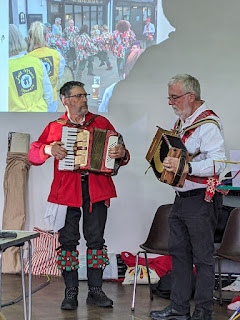Ceri Stennett, son of Stan Stennett, illustrated his talk about his father's career in pantomime with slides of the pantos' advertising posters. Stan was a Cardiff lad. He was an orphan but had a happy childhood, raised by relatives. He was an extrovert and happy to be a show off. Stan had wanted to join the RAF during WWII but his eyesight wasn't good enough, being almost blind in one eye after a childhood mishap. So he joined the artillery. After the war, he entered talent contests and won one. The prize was theatre work for the BBC, and so his love of theatre work began.
In the early years of his career, Stan worked as a lorry driver during the day and as an entertainer in the evening. He was spotted by the comedian Ossie Morris which led to more opportunities. He appeared in the radio show, Welsh Rarebit, and became the compere, along with Harry Secombe. Stan worked with many people who became famous, such as Morecombe and Wise. Stan and Eric Morecombe shared a sense of humour, and used to play pranks on the crew with whoopee cushions. Ceri told the story of a pumpkin, being used as a prop in a show, being insured for £1,000,000 by Stan. One of the conditions of the insurance was that the pumkin never be taken on a bus. Stan took the pumpkin on to the top deck of a double-decker bus and dropped it out of the window. It smashed to bits. The insurance payment was settled at £50 and donated to charity. It was a good publicity stunt.As well as a long career in pantomime and entertainment both in the UK and abroad, Stan appeared in the TV show, The Black and White Minstrels, and in the soap opera, Crossroads. For pantos in South Wales he wrote scripts that would be particularly relevant and funny for the locals. Ceri explained that 1974 - 79 was the pinnacle of Stan's career with five years of topping the bill in the pantomimes at The New Theatre in Cardiff, and receiving an MBE for his contribution to entertainment. Stan helped raised 1000s of pounds for charity, opening fetes and such like. For a long time Stan had a stuffed dog called Bonzo as a part of his act. Unfortunately Bonzo disappeared one night, believed stolen, and had to be substituted with another dog.
Stan wanted to continue working even into his eighties, but sadly suffered a stroke during an operation to insert a heart stent. Ceri described how he sat by his father in hospital singing songs from the pantomimes. Although unable to speak, Stan moved his lips and clearly enjoyed joining in with the songs. Sadly, after three weeks in hospital, he died.
Ceri is himself something of a performer having appeared many times in pantomimes as a stand in. He also worked as a stage manager, and learned puppeteering while Sooty and Sweep were part of the cast of a pantomime. His professionalism was clear from the enjoyable, interesting and well-presented talk, which was enjoyed by all members.





















































